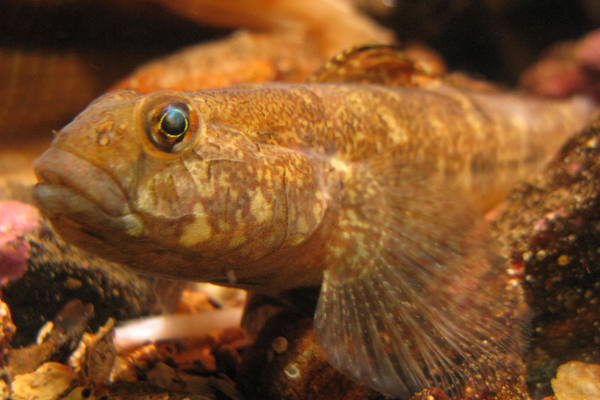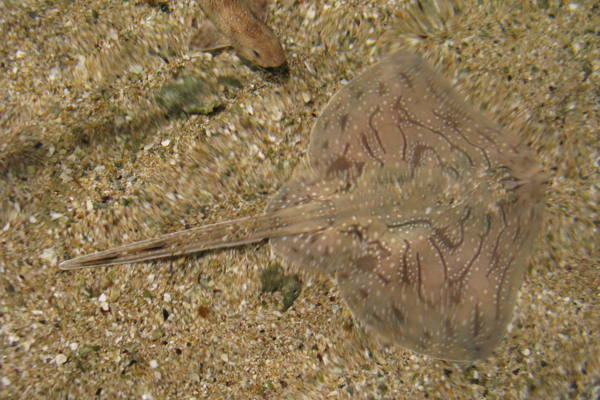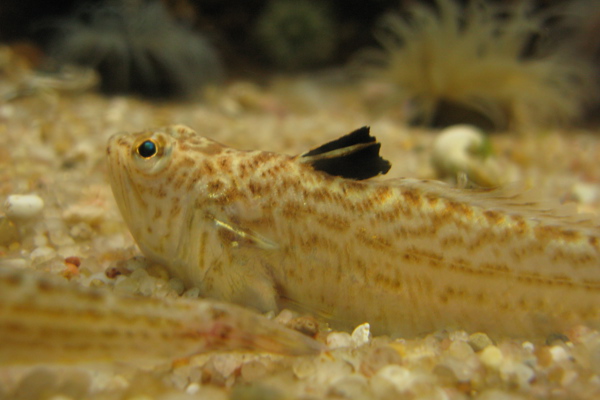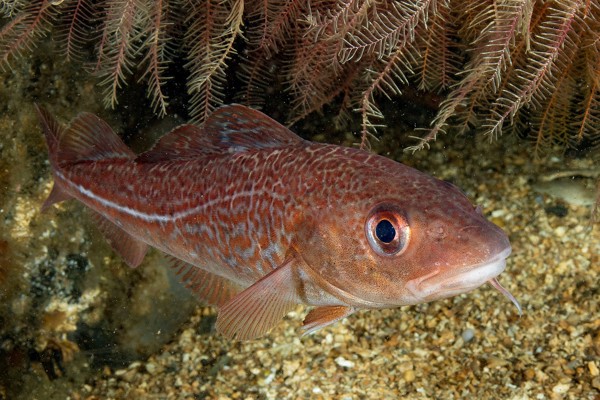Fish
The extent to which Good Environmental Status has been achieved
Marine fish were not found to be in Good Environmental Status (GES) for biodiversity. Despite the improving status of some individual populations of sensitive fish, when considering all indicators, overall fish have not achieved GES across UK seas. Most assessed populations of sensitive fish species were no longer declining in both the Greater North Sea and Celtic Seas (stable or increasing). However, long-term declines in the proportion of large demersal fish are evident in both regions. Furthermore, in the central and southern North Sea there is evidence of a shift in species composition within the fish community, toward species that do not grow large.

Thornback ray (Raja clavate) (Photo credit Trudy Russell)
Progress since previous assessments
In 2019, several sensitive species were found to be increasing in abundance in the Greater North Sea and Celtic Seas, suggesting an improving situation. Since 2019, the UK has worked with the Convention for the Protection of the Marine Environment of the North-East Atlantic (OSPAR) commission to refine the recovery of sensitive fish species indicator (previously population abundance). The assessment now uses records of occurrences (presences and absences) of species in catch data from standardized scientific groundfish surveys in order to capture changes for a greater range of species, in particular rare species that were previously not assessed for data quality reasons (Probst et al., 2023). In the updated assessment, no further declines were found in 82% of assessed populations across the OSPAR area. Many populations (49%) had increased in occurrence indicating recovery is underway for some populations.
-
In 2019, there was evidence that demersal fish communities were recovering in the Greater North Sea and Celtic Seas. However, this trend has now reversed with the size-structure and species composition deteriorating.
-
The new assessment of change in the biomass of feeding guilds finds spatially extensive increases in the biomass of benthivorous fish in both the Greater North Sea and Celtic Seas.
-
There is a mixed picture for planktivores and for those guilds feeding on larger benthic and fish prey.
How progress has been assessed
Assessment overview
In the Greater North Sea and Celtic Seas, 37 and 38 sensitive species were assessed respectively. Our assessments are based on the OSPAR Quality Status Report (QSR) 2023 which assessed the population status of marine fish, across coastal, demersal, pelagic and deep-sea groups. This found that no group was in good environmental status. Status assessments for individual fish species (including diadromous and elasmobranch species) listed by OSPAR as threatened or declining were updated in 2020-2022, and with some exceptions, were found to remain in poor status overall.
Table 1. sets out criteria with their associated targets and relevant indicators that were used to assess progress toward meeting GES for D1 Fish. For each we set out whether it has been met, not met or partially met across both UK sub regions
Table 1. Summary overview of the status assessment for Fish biodiversity (D1) assessments
|
Criteria 1 |
Bycatch mortality |
|
2019 Target |
Incidental bycatch is below levels which threaten long-term viability and recovery of fish populations |
|
Indicator |
Bycatch Mortality (to be developed) |
|
Greater North Sea |
Not used |
|
Celtic Seas |
Not used |
|
Criteria 2 |
Population occurrence |
|
2019 Target |
The occurrence of sensitive species is not decreasing due to anthropogenic activities and long-term viability is ensured. |
|
Corresponding OSPAR QSR 2023 Common Indicator |
Recovery of Sensitive Fish Species |
|
Greater North Sea |
Not met |
|
Celtic Seas |
Not met |
|
Corresponding OSPAR QSR 2023 Common Indicator |
Size Composition in Fish Communities |
|
Greater North Sea |
Not met |
|
Celtic Seas |
Not met |
|
Corresponding OSPAR QSR 2023 Common Indicator |
Proportion of Large Fish (Large Fish Index) |
|
Greater North Sea |
Not met |
|
Celtic Seas |
Not met |
|
Corresponding OSPAR QSR 2023 Common Indicator |
Pilot Assessment of Feeding Guilds |
|
Greater North Sea |
Not met |
|
Celtic Seas |
Not met |
|
Corresponding OSPAR QSR 2023 Common Indicator |
Pilot Assessment of Mean Maximum Length of Fish |
|
Greater North Sea |
Not met |
|
Celtic Seas |
Not met |
Detailed assessments
Populations of sensitive fish (excluding commercial stocks) are assessed within the UK Marine Strategy for two regions, the Greater North Sea and Celtic Seas. Most assessed populations were no longer declining (stable or increasing): 79% in the Greater North Sea (26 of 33 species), 73% in the Celtic Seas (19 of 26 species). Furthermore, many assessed populations were found to be recovering in the long-term: 42% in the Greater North Sea (14 species), 46% in the Celtic Seas (12 species). However, several populations remain at their lowest observed levels, indicating depleted populations that are not recovering (27% in Celtic Seas and 21% Greater North Sea) including some with signs of recent further decline: starry ray (Amblyraja radiata) and pollack (Pollachius pollachius) in the Greater North Sea and lumpfish (Cyclopterus lumpus) in the Celtic Seas.
-
Long-term declines are evident in the proportion of large demersal fish in both regions.
-
There is evidence of a shift in species composition within the community, toward species that do not grow large, in the central and southern North Sea.
-
Despite overall declines, the typical length of demersal fish has increased in some subdivisions, including the Irish Sea, Bristol Channel, north-eastern English Channel and northern North Sea. There is some evidence that this increase followed the decrease in fishing effort by otter trawlers in the North Sea during the early 2000s.
-
There was a mixed picture for change in the biomass of fish feeding guilds with the following observed:
-
Benthivores showed spatially extensive increases in the biomass in both the Greater North Sea and Celtic Seas.
-
Piscivores and other feeding guilds higher in the food web also showed spatially extensive increases in biomass, but with decreases detected in the north and western North Sea.
-
Planktivorous fish feeding lower in the food web declined in the Celtic Sea and north-western North Sea but increased in the English Channel, Bristol Channel and west of Scotland.
Achievement of targets and indicators used to assess progress in 2024





Drivers, activities and pressures affecting the state of the marine environment
The extraction of biomass through fishing activities remains the dominant pressure on fish populations in the North-East Atlantic and the most significant factor affecting the abundance of our fish species. Reduced fish biomass impacts feeding opportunities for marine predators such as seabirds and marine mammals and can potentially lead to a decrease in carbon fixation by the marine ecosystem. Additional pressure on fish habitat and migration routes arises from energy generation, contaminants, coastal defence, land claim and aggregate extraction (OSPAR, 2023). Climate change can impact fish directly (e.g. metabolism) and via the food web (e.g. through planktonic prey). Fisheries activities can exert both direct and indirect pressures on both commercial and non-commercial fish populations.

Pollack (Pollachius pollachius). Photo credit Angela Gall
Impact of pressure on ecosystem services
Fish provide many ecosystem services including in regulating the balance of the food web. The degree to which fish influence the regulation of food web dynamics can vary depending on the physical and climatic conditions they are subjected to. Fish also provide biomass that can be harvested by humans and change in their geographic distribution can also lead to shifts in commercial fisheries. Reduced fish biomass also impacts feeding opportunities for birds and mammals.
Impacts of climate change on pressures and state
General trends of ocean warming impacts include distributional shifts towards northern ranges of fish distributions; larger species decreasing in body size while smaller fish may more readily adapt to the environment; earlier spawning; and changes in fish biomass which may be reflected through geographic changes in catch. Furthermore, warming may alter the reproductive output of fish and change growth and mortality rates. For a full review see UK Marine Climate Change Impacts Partnership (MCCIP) (Fox et al., 2023).
Climate-associated changes in oceans projected by global models include rising sea temperatures and changes to primary production. Warming in the North Atlantic is expected to continue with the greatest warming predicted for the Atlantic-Arctic (Peck and Pinnegar, 2018). Both changes in temperature and primary production have been linked to changes in the distribution of fish species (Peck and Pinnegar, 2018; Thompson et al., 2023; Townhill et al., 2023).
Management actions taken
The actions we are taking to achieve GES are set out in the UK Marine Strategy Part 3 2025: Programme of Measures.
The UK introduced the Fisheries Act 2020 and published the Joint Fisheries Statement in 2022 which includes policies to restore fish stocks, reduce bycatch and minimise catches of sensitive species. This has led to a greater proportion of fish stocks fished at sustainable levels. Concurrent with this change, greenhouse gas emissions by UK fishing vessels reduced 17% between 2005–2009 and 2015–2019 without loss of total landings (Engelhard and others. 2022). Total emissions by the UK fishing fleet were estimated to be approximately 800kt carbon dioxide-equivalent in 2019 and 700 kt carbon dioxide-equivalent in 2020, which was <1% of UK domestic transport emissions. Notably, emissions from fisheries typically produce lower emissions per kg of fish than red meat production (Parker and others., 2018).
Fishing effort is managed annually through the allocation of quota which, informed by ICES scientific advice, sets the maximum allowable catch for each stock. Technical measures for purposes such as the protection of spawning habitat and the reduction of non-target species bycatch are implemented through fishing vessel licence conditions and regulations. Some additional actions are highlighted below:
-
The UK published its first five Fisheries Management Plans (FMPs) in 2023. A further suite of FMP publications is planned for 2024.
-
In 2022 the UK brought into force a byelaw to close the western Dogger Bank to trawling, to protect the area from bottom towed fishing gear.
-
In 2023, three Highly Protected Marine Areas were created in English waters and, in 2024, bottom towed fishing gears were prohibited in 13 marine protected areas.
-
Marine Protected Areas in Scotland have been introduced (including the Red Rocks and Longay MPA in 2021, a deep-sea marine reserve and 16 other sites in 2020).
-
The Marine Protected Area (MPA) Network Management Action Plan for Wales (2022-2023) was published in 2022 and sets out the priority network-level actions to improve MPA management.
-
Wales introduced the Whelk Permitting order to ensure the sustainability of the whelk stock (The Whelk Fishing Permit (Wales) Order 2021)
-
Regulations were introduced to manage fishing in Northern Ireland inshore marine protected areas in 2022.
Next steps
Evidence challenges
We are seeing benefits of our interventions which continue to reduce anthropogenic pressures on our sensitive fish species, but the challenges remain:
-
To continue to improve our understanding of cause and effect of individual and cumulative impacts of human-derived pressures on sensitive fish species in a dynamic marine environment.
-
To finalise the development of our bycatch mortality indicator.
Other headline challenges related to:
-
Total Allowable Catches (TACs), which are subject to negotiations through annual fisheries consultations with the EU and other coastal states: the UK will not be able to unilaterally achieve the targets without international cooperation.
-
Research and development of specific measures that will halt and reverse the decline of specific species in a timely manner.
-
The recovery of fish communities is also affected by biological and climatic conditions, which are beyond the control of fisheries managers.
Operational objectives
Outside of formal measures, to help us continue progress toward meeting GES, the following operational activities will be undertaken:
-
Work with the EU to develop multi-year strategies to improve fisheries management and the evidence and data gathering which underpins this.
-
For sensitive fish species (D1), we will seek to develop an indicator for bycatch mortality and establish the feasibility of setting threshold values.
-
The UK Fisheries Act has set out clear objectives to ensure that fisheries and aquaculture activities are environmentally sustainable in the long-term, that we deliver on MSY in line with our international obligations, and that we apply an ecosystems-based approach to fisheries management measures that accounts for the full range of effects of fishing on ecosystem services, and corresponding societal needs in our decisions.
Technical Detail: Good Environmental Status for the next cycle
Since 2019, the UK has worked with OSPAR to refine the population abundance indicator (now titled ‘Occurrence’) to give population by population assessment outcomes for a greater range of species. Table 2 shows the overarching targets (characteristics) for GES, along with their criteria, individual GES targets and associated indicators for the next assessment cycle (subject to change following the UK Marine Strategy Part 1 public consultation).
Table 2. GES criteria and targets for fish biodiversity in the next assessment cycle.
Overarching target: The abundance and demography, occurrence and bycatch of sensitive fish species indicate healthy populations that are not significantly affected by human activities.
|
Criteria |
2024-2030 GES targets |
Comment |
Indicators to be used |
|||||
|
Population abundance |
Sensitive species are not decreasing due to anthropogenic activities and long-term viability is ensured. |
No substantive change |
|
|||||
|
Bycatch mortality |
Incidental bycatch is below levels which threaten long-term viability and recovery of fish populations. (to be developed) |
NA |
|
|||||
References
Engelhard, G.H., Harrod, O.L., Pinnegar, J.K. (2022) Carbon emissions in UK fisheries: recent trends, current levels, and pathways to Net Zero Final report for Defra project C8118. Centre for Environment, Fisheries & Aquaculture Science (Cefas), Lowestoft, UK
Fox, C.J., Marshall, C., Stiasny, M.H. & Trifonova, N. (2023) Climate Change Impacts on Fish of Relevance to the UK and Ireland. MCCIP Science Review, 17pp. https://doi.org/10.14465/2023.reu10.fsh
OSPAR (2023). Fish Thematic Assessment. In: OSPAR, 2023: Quality Status Report 2023. OSPAR Commission, London. Available at https://oap.ospar.org/en/ospar-assessments/quality-status-reports/qsr-2023/thematic-assessments/fish/pressures/
Parker, R.W.R., Blanchard, J.L., Gardner, C. and others. (2018) Fuel use and greenhouse gas emissions of world fisheries. Nature Clim Change 8, 333–337. https://doi.org/10.1038/s41558-018-0117-x
Peck, M. A., & Pinnegar J. K. (2018) “Chapter 5: Climate change impacts, vulnerabilities and adaptations: North Atlantic and Atlantic Arctic marine fisheries” in Impacts of Climate Change on Fisheries and Aquaculture: Synthesis of Current Knowledge, Adaptation and Mitigation Options (FAO Fisheries and Aquaculture Technical Paper No. 627. FAO, pp. 87–111.
Pinnegar, J.K., Garrett, A., Wouters, J., Kelly, R., Stiasny, M.H. & Marshall, C.T. (2018) Climate Change Impacts on Commercial and recreational Fisheries Relevant to the UK and Ireland. MCCIP Science Review 2023, 29pp. https://doi.org/10.14465/2023.reu11.fis
Probst WN, Lynam CP, Bluemel JK., Clarke M. (2023) Assessing change in the occurrence of rare species using the binomial distribution. Ecological Indicators 156, 111084 https://doi.org/10.1016/j.ecolind.2023.111084
Townhill, B. L., Couce, E., Tinker, J., Kay, S., & Pinnegar, J. K. (2023). Climate change projections of commercial fish distribution and suitable habitat around north western Europe. Fish and Fisheries, 24, 848–862. https://doi.org/10.1111/faf.12773
Thompson, M. S. A., Couce, E., Schratzberger, M., & Lynam, C. P. (2023). Climate change affects the distribution of diversity across marine food webs. Global Change Biology, 29, 6606–6619. https://doi.org/10.1111/gcb.16881
Contributors
Christopher Lynam1
1Cefas
Acknowledgements: Joanna Bluemel1, Murray Thompson1, Robert Thorpe1 and contributors Healthy & Biologically Diverse Seas Evidence Group (HBDSEG) members.
